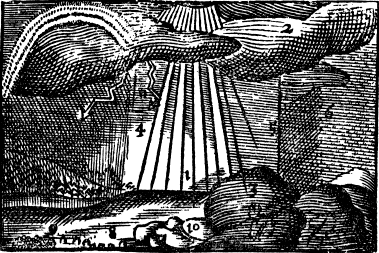JF Ptak Science Books Quick Post
Poetry has a place and a time for itself, though I've never really understood it. Most of the poetry that speaks to me is probably required to have qualifier punctuation marks, like "poetry"--it is the poetry in found and established situations, unintentional poetry, free-range poetry that fits a peculiar geometry. Not that this is poetry to many other people, and I certainly don't mean disrespect in volunteering volunteer word strings as poetical devices, but sometimes it just works--like explaining a Joseph Cornell assembly, some arrangements just work well together because they do.
Here's an example of what I'm talking about--it appeared on this blog last November but without explanation (for reasons unknown) and may have proved a little baffling to some readers. In any event I've recovered it with this tiny introduction and present the "findedness" of its poetical assembly below.
A Vapour Ascendeth from Water
(1726)
[Image from John Comenius, Orbis Senfualium Piélus: Omnium Principalium in Mundo Rerun/ Vita Аllопит, translated as Pictura et Nomenclatur, the Visible World, or A Nomenclature, and Pictures of all Chief Things that are int he World, translated into English by Charles Hoof...1726. See an earlier post here for more on Comenius. Image Source: PROJECT GUTENBERG.]
Clouds
A Vapour, (1). ascendeth
from the Water.
From it a Cloud, (2).
is made, and a white Mist, (3).
near the Earth.
Rain, (4).
and a small Shower
distilleth out of a Cloud,
drop by drop.
Which being frozen, is Hail, (5).
half frozen is Snow, (6).
being warm is Mel-dew.
In a rainy Cloud,
set over against the Sun
the Rainbow, (7). appeareth.
A drop falling into the water
maketh a Bubble, (8).
many Bubbles make
froth, (9).
Frozen Water
is called Ice, (10).
Dew congealed,
(13) is called a white Frost
Thunder is made of
a brimstone-like vapour,
which breaking out of a Cloud,
with Lightning, (11).
thundereth and
striketh with lightning
This is simply the text from the annotation on this section on clouds from Comenius' popular work presenting the state of human knowledge--the text has simply been re-spaced. The reallocation of space in the few lines of text have (to my mind) given it a more artistic and eloquent quality. But maybe I'm looking too hard at it....




Comments